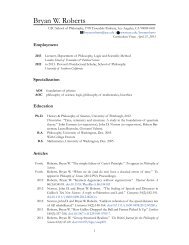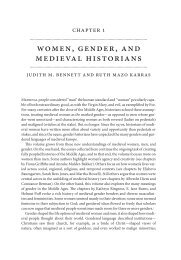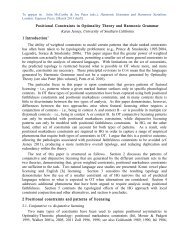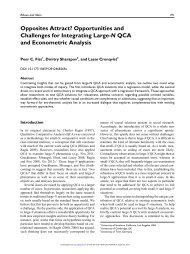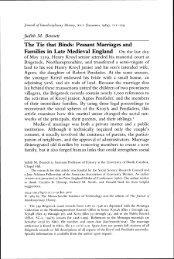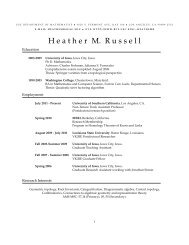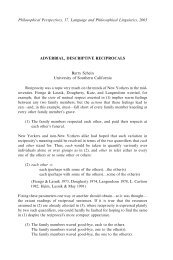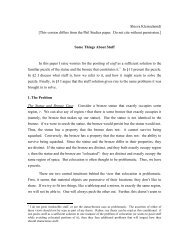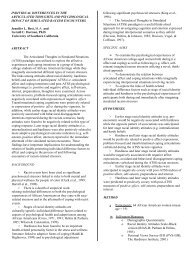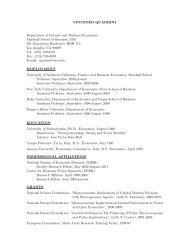The Diffusion of Ideas over Contested Terrain - Personal World Wide ...
The Diffusion of Ideas over Contested Terrain - Personal World Wide ...
The Diffusion of Ideas over Contested Terrain - Personal World Wide ...
Create successful ePaper yourself
Turn your PDF publications into a flip-book with our unique Google optimized e-Paper software.
8<br />
<strong>The</strong> use <strong>of</strong> closely related measures such<br />
as Bonacich’s (1972) power index had<br />
essentially no effect on our results, so we<br />
followed Davis and Greve (1997) in using<br />
degree centrality as the simpler measure.<br />
#2144-ASQ V49 N4-December 2005—file: 49401-fiss<br />
with others in the sample. 8 All data on board membership<br />
were collected from the firms’ annual reports and updated<br />
annually. Because CEOs and other members <strong>of</strong> the management<br />
board <strong>of</strong>ten sit on the supervisory boards <strong>of</strong> other companies,<br />
all members <strong>of</strong> the management board and supervisory<br />
board were included in the analysis.<br />
<strong>The</strong> presence <strong>of</strong> institutional investors other than domestic<br />
banks may also influence the likelihood <strong>of</strong> adopting a shareholder<br />
value orientation, as ownership by such institutional<br />
investors has been linked to the emergence <strong>of</strong> the shareholder<br />
value movement in the U.S. (Useem, 1993, 1998; Hansmann<br />
and Kraakman, 2001). We therefore controlled for<br />
blockholdings by foreign banks, foreign and domestic insurance<br />
firms, and other widely held financial institutions such<br />
as investment and pension funds (cf. Gorton and Schmid,<br />
2000).<br />
Union strength may also influence changes in a firm’s g<strong>over</strong>nance<br />
regime. Within the German system <strong>of</strong> co-determination,<br />
unions have traditionally held a strong position vis-à-vis<br />
management due to the legal requirement <strong>of</strong> worker representation<br />
on the board <strong>of</strong> directors and the system <strong>of</strong> elected<br />
worker representatives known as works councils. Furthermore,<br />
unions were very vocal in their critique <strong>of</strong> a shareholder<br />
value orientation, which they equated with an “unadulterated<br />
capitalism” (“Kapitalismus pur”) pursued by corporate<br />
“Rambos” (e.g., Der Spiegel, 1997).<br />
Unfortunately, data on union membership at the firm level are<br />
not available in Germany (Ebbinghaus and Visser, 2000).<br />
Instead, we used unionization <strong>of</strong> works councilors as an indicator<br />
<strong>of</strong> union strength. Unionization <strong>of</strong> works councilors is<br />
likely to be a good indicator <strong>of</strong> union strength because the<br />
firm’s elected worker representatives hold comparatively farreaching<br />
rights <strong>of</strong> information, consultation, and veto. For<br />
example, management cannot act on issues <strong>of</strong> job and bonus<br />
rates, <strong>over</strong>time, or the introduction <strong>of</strong> new payment methods<br />
without the agreement <strong>of</strong> the works council (Hübler and Jirjahn,<br />
2003). We measured union strength using the percentage<br />
<strong>of</strong> works council seats captured by union representatives<br />
in the firm’s corresponding industry. Data on the works council<br />
elections held in 1990, 1994, and 1998 come from the<br />
Institut der Deutschen Wirtschaft, Cologne.<br />
We controlled for performance using an accounting-based<br />
and a market-based measure, namely, total returns and<br />
return on assets (ROA) (Westphal and Zajac, 1994). We also<br />
controlled for firm size using the log <strong>of</strong> sales and the log <strong>of</strong> a<br />
firm’s year-end market capitalization, and we controlled for<br />
diversification using the number <strong>of</strong> four-digit standard industrial<br />
classification (SIC) industries in which a firm operates. To<br />
account for industry-specific differences, we included dummy<br />
variables for the firms’ two-digit SIC codes as reported in the<br />
<strong>World</strong>scope database. Data on performance and size were<br />
also collected from <strong>World</strong>scope. Finally, we controlled for<br />
time effects by including year dummy variables in all analyses.<br />
Due to the large number <strong>of</strong> variables, coefficients for<br />
industry and year dummies are not reported in the tables.<br />
518/ASQ, December 2004



